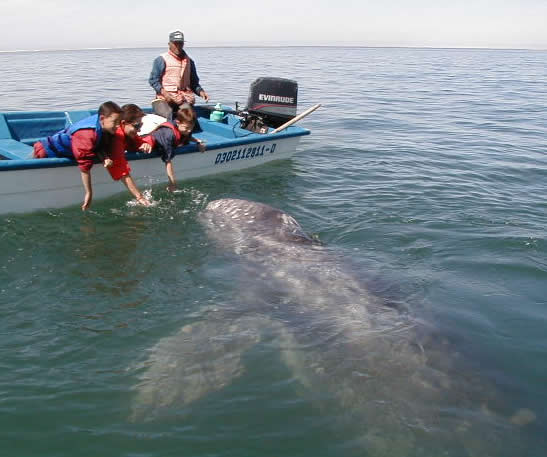It is unknown how long Pacific Gray whales have visited the warm, shallow lagoons of Baja's pacific coast to give birth and mate. In the 19th Century, they were hunted down and massacred in such large numbers that the population was almost completely decimated within 50 years. When commercial whaling stopped in the 1940"s, the whales began to rebound and the lagoons that once heralded the death of an entire species once again became the place where gray whales, 100% Mexican by birth, found refuge.
Learn about whale biology and the people who are trying to protect these magnificent mammals.
You'll find links to the class handouts used at ISSI (Intensive Spanish Summer Institute) here and in the ISSI archives. You can also link to the vocabulary list for this topic or see the spanish translation by clicking on individual red words in the text below. A fact sheet is here.
Gray Whale Natural History
 The pacific gray whale (Eschrichtius robustus) is a mammal in the Order Cetacea. Whales are relatives of dolphins and porpoises. Like all members of this order, grays use echolocation to communicate and navigate. As an adult, the gray usually reaches a length of about 45 feet and can weigh 30-40 tons. The gray whale belongs to the group known as baleen whales which also includes the Blue Whale, Humpback Whale, and Right Whale. They use specialized comb-like structures made of keratin, baleen, that are attached to their jaws to filter small marine organisms such as crustaceans and tube worms that they scoop up in large mouthfuls from the ocean bottom. Pleats in their sides allow the mouth to swell as they fill their mouths with water and then strong muscles squeeze the water out through the baleen, trapping food particles inside the mouth.
The pacific gray whale (Eschrichtius robustus) is a mammal in the Order Cetacea. Whales are relatives of dolphins and porpoises. Like all members of this order, grays use echolocation to communicate and navigate. As an adult, the gray usually reaches a length of about 45 feet and can weigh 30-40 tons. The gray whale belongs to the group known as baleen whales which also includes the Blue Whale, Humpback Whale, and Right Whale. They use specialized comb-like structures made of keratin, baleen, that are attached to their jaws to filter small marine organisms such as crustaceans and tube worms that they scoop up in large mouthfuls from the ocean bottom. Pleats in their sides allow the mouth to swell as they fill their mouths with water and then strong muscles squeeze the water out through the baleen, trapping food particles inside the mouth.
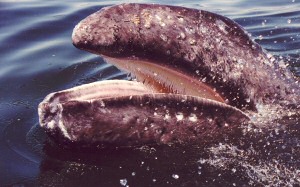 Life Cycle. Gray whales spend their summers (July to Sept.) feeding in the cold, nutrient rich waters of the Arctic’s Bering and Chukchi seas. As winter approaches, they begin a journey that is the longest known migration of a mammal. They complete the 5000 to 7000 mile journey in just under two months, swimming non-stop down the pacific coast of North America to the shallow coastal lagoons of the Baja California peninsula. Once they arrive at the lagoons in December, courtship and mating ensues while, females who mated in the lagoons the year before, will give birth to their calves. Newborn calves are about 16 feet long and may weigh up to 1500 pounds. Calves may gain 60-70 pounds a day on the fat rich milk (53% fat) their mothers provide. The whales feed very little while migrating or in the lagoons and must live off of the thick layer of blubber deposited in the summer. For more detailed information about whales, their migration and a live update of their current location, visit Journey North. Another excellent site is The American Cetacean Society.
Life Cycle. Gray whales spend their summers (July to Sept.) feeding in the cold, nutrient rich waters of the Arctic’s Bering and Chukchi seas. As winter approaches, they begin a journey that is the longest known migration of a mammal. They complete the 5000 to 7000 mile journey in just under two months, swimming non-stop down the pacific coast of North America to the shallow coastal lagoons of the Baja California peninsula. Once they arrive at the lagoons in December, courtship and mating ensues while, females who mated in the lagoons the year before, will give birth to their calves. Newborn calves are about 16 feet long and may weigh up to 1500 pounds. Calves may gain 60-70 pounds a day on the fat rich milk (53% fat) their mothers provide. The whales feed very little while migrating or in the lagoons and must live off of the thick layer of blubber deposited in the summer. For more detailed information about whales, their migration and a live update of their current location, visit Journey North. Another excellent site is The American Cetacean Society.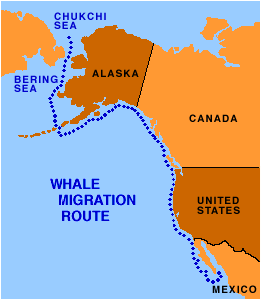
There are a number of reasons that the lagoons are ideal whale nurseries. They are surrounded by hot desert terrain and the sun and dry air quickly evaporates water from the lagoon’s surface, thereby increasing the lagoon’s salinity, and the water’s buoyancy. The added buoyancy assists newborn whale calves while they learn to swim. The shallow lagoons also offer protection from killer whales, their principle predators. Finally, the lagoons continue to be relatively free of high-volume human activity and the shores for the most part remain undeveloped.
In February or March, the male grays head north at a more leisurely pace, while the females and calves remain until April, when they too head back to their Arctic feeding grounds. Mothers and there calves will travel in pods with other related females and for protection from killer whales. By they time the calves begin their first migration, they may have reached a length of 19 feet.
Conservation Status
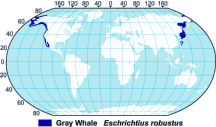 There are two distinct populations of gray whale in the Pacific Ocean. The Western North Pacific population is critically endangered, with an estimated 125-156 individuals remaining in 2010 (read more about this population from the IUCN, September 2014). Their range is from the Arctic in summer to the South China Sea in winter. Their breeding grounds are still unknown. The Eastern North Pacific grays are our California gray whales. Gray whales were hunted to near extinction in the 19th century for their meat and for their blubber, which was mainly used as a source of fuel. In 1857, the whaler Charles Scammon discovered the northernmost Baja lagoon (it was later named after him). The wholesale slaughter of whales that ensued over the next twelve years decimated the population (from an estimated 30,000 to just 2,000), causing whalers to eventually give up on the lagoons. Gray whales were called devilfish, because of their tendency to fight back and sink whaling boats when they were cornered or when their young were attacked in the shallow lagoons. In 1947 the International Whaling Commission (IWC) granted full protection to the gray whale through a whaling moratorium. Since that time the California gray has made a remarkable recovery and were removed from the U.S. Endangered Species list in 1994. They currently number between 19,000 and 23,000 individuals and some scientists believe that this is a healthy, stable population, with numbers close to their original population size. In February 2015, NOAA Fisheries debutted their Automatic Whale Detector 1.0 infrared cameras to automatically detect and count whales as they migrate. Read more on their site about this program and gray whales.
There are two distinct populations of gray whale in the Pacific Ocean. The Western North Pacific population is critically endangered, with an estimated 125-156 individuals remaining in 2010 (read more about this population from the IUCN, September 2014). Their range is from the Arctic in summer to the South China Sea in winter. Their breeding grounds are still unknown. The Eastern North Pacific grays are our California gray whales. Gray whales were hunted to near extinction in the 19th century for their meat and for their blubber, which was mainly used as a source of fuel. In 1857, the whaler Charles Scammon discovered the northernmost Baja lagoon (it was later named after him). The wholesale slaughter of whales that ensued over the next twelve years decimated the population (from an estimated 30,000 to just 2,000), causing whalers to eventually give up on the lagoons. Gray whales were called devilfish, because of their tendency to fight back and sink whaling boats when they were cornered or when their young were attacked in the shallow lagoons. In 1947 the International Whaling Commission (IWC) granted full protection to the gray whale through a whaling moratorium. Since that time the California gray has made a remarkable recovery and were removed from the U.S. Endangered Species list in 1994. They currently number between 19,000 and 23,000 individuals and some scientists believe that this is a healthy, stable population, with numbers close to their original population size. In February 2015, NOAA Fisheries debutted their Automatic Whale Detector 1.0 infrared cameras to automatically detect and count whales as they migrate. Read more on their site about this program and gray whales.
However, there is some evidence indicating that all might not be well within the herd, with the first reports in 2007 showing apparent malnutrition among about 10% of the individuals arriving at the lagoons and increased mortality noted along the migration route. In 2006-2007 the Pacific experienced an El Niño event which might have affected the nutrients available in the Arctic feeding grounds and may turn out to be a portent of future trouble for the herd as the effects of global climate change continue to impact the Arctic.
Friendly Whales
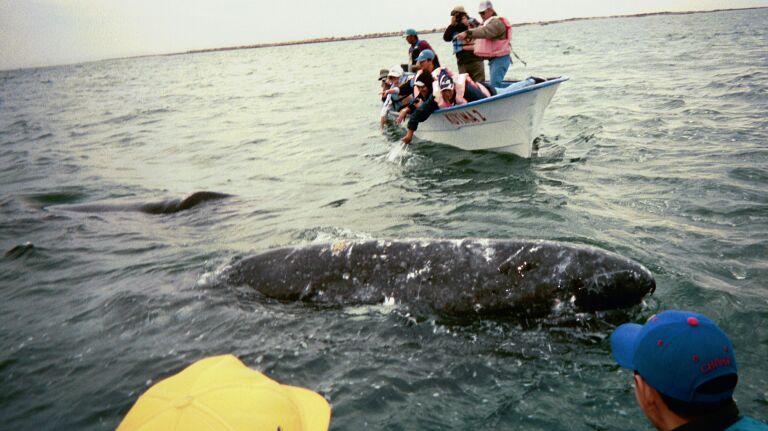
The Whale Nurseries
In 1972, the Mexican government declared Laguna Ojo de Liebre (Scammon’s Lagoon), Laguna Guerrero Negro and Laguna San Ignacio to be whale sanctuaries. In 1988, the Vizcaíno Biosphere Reserve, the largest protected area in Latin America was created and included these three lagoon systems. Finally, in 1993 the lagoons along with the cave paintings of the nearby Sierra San Francisco were named a UNESCO World Heritage Site under the Man and the Biosphere Program (MAB-UNESCO). Another large lagoon system and nursery is found farther south in Bahía Magdalena, which includes the communities of Puerto A. López Mateos and Puerto San Carlos.
In the past 20 years, more than 12,000 gray whale calves have been born in the Baja California lagoons (read source article in Spanish). Over the 2014-15 season, 2,652 individual gray whales were counted in the Baja California lagoons. Click here to read more about this past season (in Spanish only).
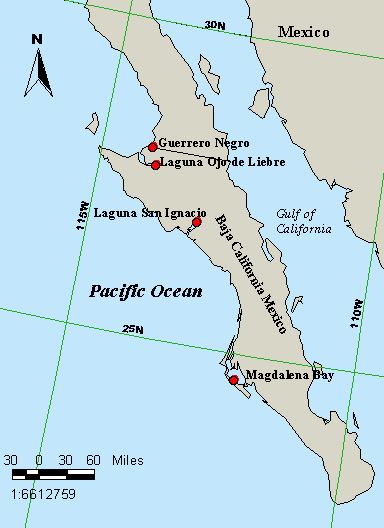 The lagoons offer more than just a gray whale nursery. Most have dense mangrove stands along the shorelines and estuaries which host sea turtles and a large variety of migratory water and shore birds. To some degree, the Mexican government has tried to ensure that the whales are protected as it is obligated to work within the guidelines of the Biosphere Reserve and World Heritage Site. However, commercial fishing and some illegal development has been allowed to occur along some parts of the lagoons. Enforcement of regulations is especially difficult due to the inadequate resources allocated to the immense reserve.
The lagoons offer more than just a gray whale nursery. Most have dense mangrove stands along the shorelines and estuaries which host sea turtles and a large variety of migratory water and shore birds. To some degree, the Mexican government has tried to ensure that the whales are protected as it is obligated to work within the guidelines of the Biosphere Reserve and World Heritage Site. However, commercial fishing and some illegal development has been allowed to occur along some parts of the lagoons. Enforcement of regulations is especially difficult due to the inadequate resources allocated to the immense reserve.
The Mexican government issues concessions (permits) to ecotourism businesses offering whale watching tours during the winter months. In order to protect the whales and decrease human interference when the whales first arrive, access to the lagoons is not granted until January 1 each year. This gives the whales time to mate and give birth, while preventing potential human-whale accidents during the whale’s very active mating season and while the newborn calves are most vulnerable. The number of pangas and other tour boats are limited in both the total boats per company on the water at any given time as well as by the total number of boats on the water each day. Rules delimit the viewing areas and boat operator behavior is regulated (for instance, chasing whales or purposefully trying to get between the mother and calf is not permitted).
Endangered Lagoons?
Current Development. ESSA (Exportadora de Sal, S.A. de C.V.) is one of the world’s largest solar evaporation salt works and is located on the shores of Laguna Ojo de Liebre near Guerrero Negro, BCS. The company’s principal shareholder is the Mexican government (51%) with the other shares being held by Mitsubishi Corp..Salt is created through a year long process in which huge diesel pumps suck up to 35,000 gallons per minute from the nearby lagoon and deposit it into a series of evaporation ponds where it is left to evaporate under the desert sun and wind.  As the brine becomes more concentrated, it is successively pumped from one evaporation pond to the next and then finally into crystallization ponds once it has reached a certain level of purity. As the brine continues to concentrate, crystals of almost pure sodium chloride will form and fall to the bottom of the pond. These are later scraped up by gigantic bulldozers, loaded onto massive transport vehicles, unloaded and washed, then loaded first onto a barge and then to ships at Isla Cedros for transport overseas for industrial use. Learn more about salt production (Spanish version only). The salt works has been in operation since 1957 and in recent years, has become more diligent in protecting the wildlife in the nearby lagoons. Access to the lagoon is actually obtained by driving through locked gates onto the salt works property and past the many ponds to the whale watching launch sites.
As the brine becomes more concentrated, it is successively pumped from one evaporation pond to the next and then finally into crystallization ponds once it has reached a certain level of purity. As the brine continues to concentrate, crystals of almost pure sodium chloride will form and fall to the bottom of the pond. These are later scraped up by gigantic bulldozers, loaded onto massive transport vehicles, unloaded and washed, then loaded first onto a barge and then to ships at Isla Cedros for transport overseas for industrial use. Learn more about salt production (Spanish version only). The salt works has been in operation since 1957 and in recent years, has become more diligent in protecting the wildlife in the nearby lagoons. Access to the lagoon is actually obtained by driving through locked gates onto the salt works property and past the many ponds to the whale watching launch sites.
In 1994, ESSA proposed a new salt works to be built on the shore of Laguna San Ignacio (LSI) to the south. The project was to have been even larger than the project in Guerrero Negro, with 16 diesel pumps removing water from the lagoon, a mile long pier jutting out into the Pacific for loading the salt directly onto the transport ships and miles and miles of dykes and pipelines crossing through isolated desert and the Biosphere Reserve. The communities that would be most affected by the project rejected it, stating that the presence of the pumps and machinery 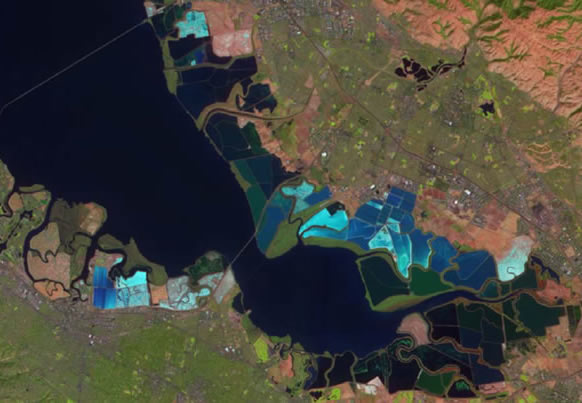 close to the whale nursery would have a detrimental effect on the whales (as well as on other wild life that traverse the pristine, undisturbed area) and would thus jeopardize their livelihood. Additionally, the proposed pier would have been placed right on top of the lobster, scallop and abalone beds that the 80 families in the cooperative had maintained sustainably for 45 years.
close to the whale nursery would have a detrimental effect on the whales (as well as on other wild life that traverse the pristine, undisturbed area) and would thus jeopardize their livelihood. Additionally, the proposed pier would have been placed right on top of the lobster, scallop and abalone beds that the 80 families in the cooperative had maintained sustainably for 45 years.
A six year battle ensued, mainly aimed at Mitsubishi. The locals’ petitions to the government fell on deaf ears so they enlisted the help of a number of Mexican and international environmental groups, most notably Grupo Cien and NRDC (Natural Resources Defense Council). The environmentalists launched an international campaign that included letter-writing, a boycott of Mitsubishi products and a “Save the Whales” media campaign with international celebrities descending on the lagoon to schmooze with the whales. They also examined the meager economic benefits promised by ESSA (electricity, jobs, etc.) and strategized with the local cooperatives and ejidos on a development plan that would be sustainable, eco-friendly and use alternative energy sources to help modernize the isolated communities, all the while maintaining the already relatively high standard of living that most of the fishermen and ecotourism businesses were enjoying.
In 2000, at the height of the conflict, President Ernesto Zedillo traveled to the lagoon with his family to check out what all the uproar was about and to see the friendly whales. Within minutes of arriving in the viewing area, a calf approached their boat. Bending over the side of the panga, Zedillo’s wife planted a kiss on the calf’s nose then immediately burst into tears. At that moment, Zedillo, who had been unresponsive to the community’s appeals, must have felt like a cornered man. Just five days later upon his return to the capitol, he announced in a national press conference that the salt works project was dead and that as a national treasure, the lagoon should be off limits to development such as that proposed by ESSA. The decision offered Zedillo a way to save face; no doubt his marriage as well. It was a big win for the lagoon and it validated what the activists had been asserting all along—that the Mexican government could not ignore the designation of the area as a Biosphere Reserve and World Heritage Site along with all of the regulations and restrictions on development that these designations demanded. Nor could it do anything to endanger a national treasure, one that was after all, “100% Mexican by birth.”
Salt Works Chapter 2. Local, sustainable eco-projects at LSI went forward with NGO assistance after the 2000 decision and the salt works project was deemed to be dead. So it was with surprise that word came of ESSA’s plan to revive the project in 2005 under a new more pro-development Federal government. Activists changed their strategy this time, choosing one that had recently gained popularity and proved effective in the US, that of the conservation easement.
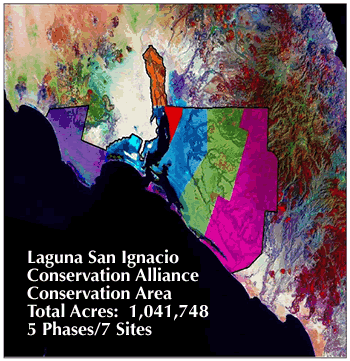 A conservation easement (CE) places a piece of property under protection in perpetuity from particular types of development (designated within each contract) while still granting the landowner use of the land as well as a yearly or lump sum payment for honoring the contract. In 2005, five NGOs formed the LSI Conservation Alliance. With donations, the Alliance was able to negotiate with Ejido Luís Echeverría Álvarez for a CE on over 140,000 acres of its land along the southern shore of the lagoon. In 2006, the Mexican government approved the protection of 65,500 acres of federal land along the western shoreline. Currently the Alliance is trying to raise funds for a CE to protect an additional 174,000 acres belonging to Ejido Emiliano Zapata on the lagoon’s north shore. The ultimate goal is to protect all one million acres of the lagoons shoreline in perpetuity for future generations of Mexicans, thus prohibiting urban and industrial development while still allowing for sustainable, low-impact, eco-friendly projects.
Download the complete Conservation Plan.
A conservation easement (CE) places a piece of property under protection in perpetuity from particular types of development (designated within each contract) while still granting the landowner use of the land as well as a yearly or lump sum payment for honoring the contract. In 2005, five NGOs formed the LSI Conservation Alliance. With donations, the Alliance was able to negotiate with Ejido Luís Echeverría Álvarez for a CE on over 140,000 acres of its land along the southern shore of the lagoon. In 2006, the Mexican government approved the protection of 65,500 acres of federal land along the western shoreline. Currently the Alliance is trying to raise funds for a CE to protect an additional 174,000 acres belonging to Ejido Emiliano Zapata on the lagoon’s north shore. The ultimate goal is to protect all one million acres of the lagoons shoreline in perpetuity for future generations of Mexicans, thus prohibiting urban and industrial development while still allowing for sustainable, low-impact, eco-friendly projects.
Download the complete Conservation Plan.
File Downloads
Bajar documentos
- Friendly Whales Class Handout (ISSI)
- Friendly Whales Presentation (ISSI)
- Presentación de las ballenas amistosas (ISSI)
- Vocabulary list (ISSI)
- Whales thriving in Lagoons (2010 article - English) PDF | RTF (doc)
Links
Enlaces
Biology / Biología
American Cetacean Society
Gray whale characteristics
Gray whale fact sheet ACS
Another fact sheet
National Geographic Whale Page
Nice range and migration maps
Conservation & Ecotourism / Conservación y Ecoturismo
Ecoturismo Kuyima (San Ignacio, BCS)
Laguna San Ignacio Ecosystem
Science Program
NRDC (National Resources Defense Council)
Wildcoast (conservation group working with whale lagoons, coastal issues)
Casa Leree Bookstore
(San Ignacio)
Baja’s Friendly Whales
(Reader’s Digest article)
Watching whales watching us
New York Times article 07/2009
More links to articles and videos can be found in the ISSI archive

